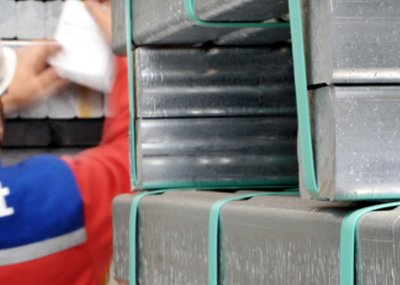The percentage of recycled aluminum in the production of the light metal aluminum is becoming increasingly important at Trimet Aluminium SE. An ever-increasing amount of the material in circulation goes hand-in-hand with increasing amounts of aluminum scrap. The reutilization of aluminum does not impair its quality and application diversity, and uses significantly less energy.
Trimet Aluminium SE attaches increasing importance to the long-term recycling of aluminum. Already today, 200,000 tons of aluminum scrap are melted down annually and made available for re-use in the production plants of the materials specialist. In addition to Trimet’s remelting plants in Gelsenkirchen and Harzgerode, the company increasingly uses the recycled material in the foundry of its primary location in Essen for the production of rolled ingots and billets. Here alone, 80,000 tons of aluminum scrap are utilized annually. In this process, hot liquid aluminum, produced at about 1,000 degrees by electrolysis, is used to melt the scrap. At the same time, the scrap cools the liquid aluminum to the required temperature for further processing in the foundry. This saves the additional energy used for melting the aluminum scrap.
“By increasingly using aluminum scrap from our customers and also third parties on the market for producing primary aluminum, we are significantly increasing the energy efficiency of the production process. This also improves the eco-balance of the products for which our aluminum is used later on,” says Thomas Reuther, Member of the Management Board of Trimet Aluminium SE. Currently, about 200,000 tons of aluminum scrap are in circulation in the Trimet production plants.
Material quality is maintained with less energy consumption
The aluminum quality is fully retained in the recycling process. The remelting of aluminum only requires about five percent of the energy used for the initial production of the material through fused-salt electrolysis. Using the heat of liquid aluminum can even largely eliminate this outlay. In this way, every round of recycling improves the environmental performance of aluminum. “Due to the continuing high demand for the material and its wide variety uses, there is more aluminum in circulation every year. The issues of sustainability and resource conser ation particularly justify a 100-percent recycling rate for the material. We are continually investing in equipment and methods to promote this development in an economic and ecologically efficient manner,” says Thomas Reuther.
Ideally, scraps with different alloys are separated from one another before being melted down in order to preserve their specific composition and corresponding properties. As a specialist for customized material solutions, Trimet also ensures at all times that the scraps are returned to the production cycle in line with the highest environmental standards.
Aluminium 2014 from October 7 to 9, 2014 in Düsseldorf – Trimet is looking forward to your visit at stand G20 in hall 9.
Source: Trimet
×


